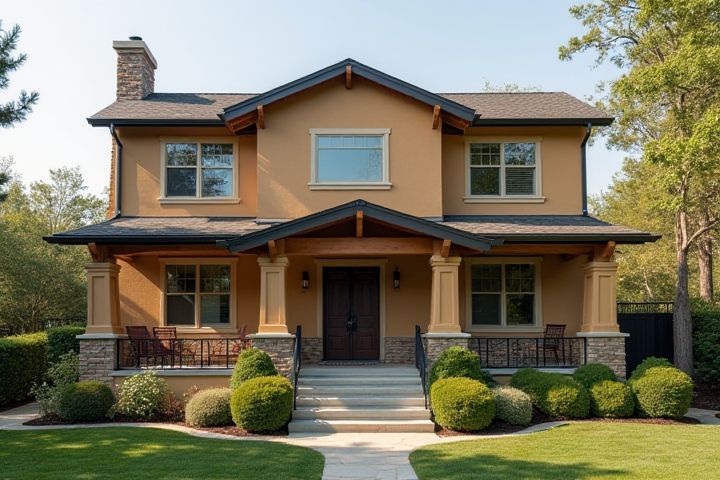
Consider the architectural style of your house when selecting a color; a Victorian home may look more charming in pastel shades, while a modern design might suit bold hues. Climate and location play crucial roles in color choice, as lighter shades reflect sunlight, keeping your home cooler in warmer areas, while darker colors can absorb heat. Nearby properties and neighborhood aesthetics can inspire your decision, ensuring that your home complements its surroundings and maintains visual harmony. It's also wise to test samples on your walls; natural light can drastically change how a color appears throughout the day. Lastly, think about how the color reflects your personality and lifestyle--your home should feel inviting and represent your tastes.
How To Choose A House Color
Neighborhood aesthetics
When selecting a house color, consider the architectural styles prevalent in your neighborhood, as this can enhance curb appeal and maintain community harmony. Examine the colors of adjacent homes to avoid clashing and to complement the overall visual landscape, ensuring your choice aligns with local trends. Natural surroundings also play a role; choose earthy tones if your area is lush with greenery or lighter hues if you are near the coast. Ultimately, select a shade that reflects your personal style while respecting the aesthetic essence of your community.
Architectural style
When selecting a house color, consider the architectural style of your home as a guiding factor. For instance, traditional Colonial homes often look best with muted and classic colors like soft whites or light grays, while modern styles can embrace bold colors like charcoal or even vibrant hues. Craftsman homes typically complement earthy tones, such as deep greens or browns, that harmonize with natural materials. Understanding the historical context and regional characteristics of your home's style will help you choose a palette that enhances its unique architectural features.
Climate considerations
Choosing a house color based on climate considerations can significantly impact energy efficiency. For warmer climates, lighter colors like whites or pastels reflect sunlight, helping to keep interiors cooler and potentially reducing air conditioning costs by up to 15%. In contrast, darker shades in colder regions absorb heat, enhancing warmth and minimizing heating expenses. Always consider local heat patterns and sunlight intensity when making your decision to improve your home's overall energy performance.
Personal preferences
Choosing a house color often begins with assessing your personal preferences, which can be influenced by your favorite colors or design styles. Consider the surrounding environment, as colors that harmonize with natural landscapes or neighboring homes create a cohesive look. You might also want to take into account the architectural style of your home, as certain colors can enhance features like trim and windows. Sample paint swatches on your exterior before committing, ensuring that the chosen hue resonates with your taste throughout different times of the day.
Color durability
When selecting a house color, prioritize hues known for their durability, such as deep blues, earthy browns, and rich greens, as they resist fading in sunlight. Consider advanced paint technologies like acrylic latex or urethane, which provide superior UV protection and weather resistance, ensuring vibrancy for years. It's essential to evaluate the surrounding environment, as colors can appear differently depending on natural light and nearby landscapes. Your choice should enhance the architectural style while also complementing the overall aesthetic of the neighborhood.
HOA guidelines
When selecting a house color, first consult your Homeowners Association (HOA) guidelines, as these often outline acceptable color palettes that maintain community aesthetics. Look for any specific restrictions regarding bright or unconventional shades, and consider shades that harmonize with neighboring homes. You might want to consider using color swatches to visualize how different hues interact with your home's architecture and the surrounding landscape. Prioritizing colors that align with HOA standards not only enhances curb appeal but also ensures compliance and fosters a sense of community cohesion.
Resale value impact
Selecting a house color significantly influences its resale value, as first impressions often stem from exterior aesthetics. Neutral shades, such as soft grays, beiges, or whites, appeal to a broader audience, enhancing marketability when listing your property. Darker hues, while stylish, may deter potential buyers who prefer a lighter and more inviting atmosphere. You should also consider the architectural style of your home and the local real estate trends to ensure that your color choice harmonizes with neighborhood standards, maximizing your investment potential.
Trim and accent harmony
To achieve trim and accent harmony, select a primary house color that complements the existing architectural features and materials. For example, if your home is made of natural wood, earth tones like muted greens or warm grays can enhance its aesthetics. Next, choose a trim color that contrasts yet harmonizes--classic white or soft cream often works well with darker shades, while bold dark hues can create a striking effect against lighter backgrounds. When selecting accent colors for doors or shutters, consider a palette that includes two to three shades from the same color family to maintain visual coherence and sophistication.
Natural lighting effects
When selecting a house color, consider the impact of natural lighting throughout the day. For north-facing homes, opt for warmer shades like yellows or creams to counteract the cool light. In contrast, south-facing houses benefit from cooler colors, such as grays or blues, which remain balanced under bright sunlight. Test paint samples at different times to see how they interact with changing light conditions, ensuring your choice harmonizes with both your environment and personal style.
Test samples on-site
Choosing a house color requires careful consideration of various factors, including the surrounding environment and architectural style. Test samples on-site, using paint swatches to see how different colors interact with natural light at various times of the day, can significantly influence your decision. Aim for colors that complement the landscape, such as earthy tones for a rural setting or bright shades for an urban backdrop. Your home's aesthetic will be enhanced by selecting a harmonious color palette that reflects both personal taste and the architectural character of the structure.
